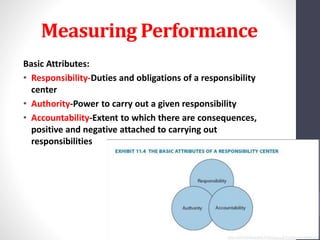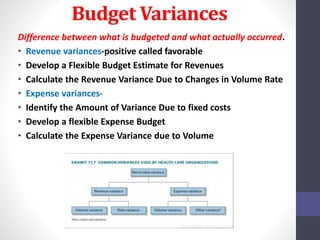Chapter 11: Responsibility Budgeting
- 2. Learning Objectives • Defining decentralization and its advantages and disadvantages • Identify the major types of responsibility centers in health care organizations • Explain the relationships of responsibility, authority and accountability • Compute volume and rate variances for revenue • Compute volume and cost variances for expenses
- 3. Decentralization • Degree of dispersion of responsibility within an organization • Advantages-More efficient use of time, more relevant info, higher quality decisions, greater speed, better use of talent, increased motivation and allegiance • Disadvantages-loss of control, decreased goal congruence, increased need for coordination and formal communication, lack of managerial talent
- 5. Responsibility Center • An organizational unit formally given the responsibility to carry out one or more tasks or achieve one or more outcomes, or both. • Types of responsibility centers: 1. Service centers 2. Cost centers 3. Profit centers 4. Investment centers
- 6. Types of Responsibility Centers
- 7. Types of Responsibility Centers
- 11. Example 1
- 12. Example 2
- 13. Solution
- 14. Measuring Performance Basic Attributes: • Responsibility-Duties and obligations of a responsibility center • Authority-Power to carry out a given responsibility • Accountability-Extent to which there are consequences, positive and negative attached to carrying out responsibilities
- 16. Budget Variances Difference between what is budgeted and what actually occurred. • Revenue variances-positive called favorable • Develop a Flexible Budget Estimate for Revenues • Calculate the Revenue Variance Due to Changes in Volume Rate • Expense variances- • Identify the Amount of Variance Due to fixed costs • Develop a flexible Expense Budget • Calculate the Expense Variance due to Volume
- 17. Example 3
- 23. Example 4
- 24. Solution:
- 26. Beyond Variances • Revenue Attainment • Cost Containment • Revenue Enhancement • Cost Avoidance
- 27. Beyond Variances
- 28. Other Financial Measures • Compensation Systems • Salary Based Compensation System • At Risk Compensation System • Mixed Compensation System • Compensation System Design
- 30. Summary • Decentralization a growing trend • Advantages and disadvantages to decentralization • Responsibilities centers include: service, cost, profit and investment • Variances must be tracked and cause determined • Compensation systems must be reviewed





























